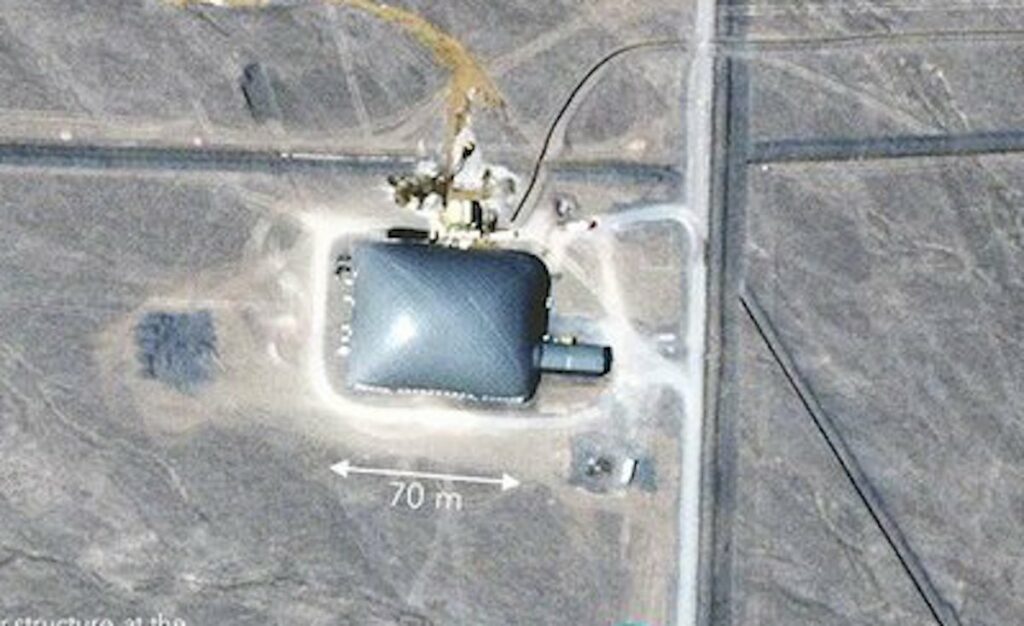This article by James R. Webb was originally published by Coffee or Die.
While looking into rumors and a report that the Chinese People’s Liberation Army was expanding its nuclear arsenal by more than 100 intercontinental ballistic missiles — a jump that would effectively double China’s nuclear missile force — a team of satellite imagery researchers in California made a stunning discovery. They didn’t find the missiles but instead stumbled across 119 new missile silos in a remote Chinese desert.
In recent satellite images, the researchers at the Middlebury Institute of International Studies at Monterey led by Jeffrey Lewis, a longtime nuclear proliferation expert, found the silos arrayed in neat rows, each separated by about 2 miles. After checking older pictures, they determined most of the building had taken place in 2021. Located in a remote area of Gansu province, nearly all the silos, the team found, were covered by large inflatable tents, leading Lewis to dub the missile field the “Bouncy Castles of Death.”
The silos represent a huge leap forward in Chinese nuclear strategy, Lewis said.

RELATED: DOD MAP SHOWS RUSSIAN AND CHINESE SUBS ARE TOO CLOSE FOR COMFORT
“We knew they were interested in silos and so now we see big silos, so now the question is sort of like, why? Why would they do that?” Lewis told Coffee or Die Magazine.
All 119 silos, Lewis said, were clearly sized to fit ICBMs, the largest class of ballistic missiles, many of which are capable of carrying multiple nuclear warheads around the globe. According to Lewis, China currently has approximately 100 total ICBMs. Though that total is still far less than the US stockpile, which is believed to be close to 500 similar missiles and thousands of warheads, the sudden building project evokes memories of the Cold War when the US and Soviet Union engaged in a decadeslong arms race, building thousands of nuke-carrying missiles and bombs. However, Lewis told Coffee or Die that with this new facility, China is likely engaging in “deceptive basing,” a sort of nuclear “shell game” developed by the US in the 1970s.
According to Lewis, when the US developed the MX missile, officials hoped to build 23 silos for every rocket. Since silos were easily discovered by Soviet planners, the missiles themselves would be shuffled around. If Russia intended to knock out US nuclear forces, they would need to target every silo as if it had a missile inside, directing missiles away from major US targets such as cities and bases. Lewis thinks that China is effectively doing the same thing.

RELATED: CARRIER WOES: THE NAVY’S FIGHTERS CAN’T REACH CHINA
“So, what I suspect they’re doing is creating a kind of version of a ‘warhead sink,’ [in] which these are 119 targets we now have to cover. It’s a kind of miniature version of what the US planned to do with the MX in the late ’70s,” Lewis said.
According to Lewis, Beijing currently has approximately 100 nuclear warheads, compared with thousands in the US arsenal. Additionally, China does not have a “first strike” doctrine for nuclear war. Chinese planners instead focus on surviving an attack, leaving Beijing the ability to respond.
China only began building the “bouncy castles of death” silos in Gansu in February. The 3 kilometer spacing between silos means a direct hit on one silo would likely leave neighboring silos intact.
“I think the point of this is to […] force the US to expend nuclear weapons hitting silos in the desert,” Lewis told Coffee or Die.

Lewis said the silo complex also demonstrates that the Chinese are unlikely to follow the US into building expensive ICBM interceptor systems. Instead, the silos are a relatively low-cost deterrent — why pay for expensive interceptors to shoot down missiles when you can give your enemy 120 extra targets to waste those missiles on?
“We have this crazy missile defense firing doctrine because [the US] system doesn’t work. They fire a salvo of four interceptors at every missile. Four interceptors cost about $300 million,” Lewis told Coffee or Die. “So if there are three warheads on a [Chinese ICBM], that’s $900 million to defend against.”
However, Lewis doesn’t think that the new silos will necessarily spark a new Cold War with China. Even if Beijing filled every new silo with an ICBM, China would still only possess a fraction of the US arsenal. Rather, Beijing is adjusting to what it views as a growing US missile defense capability and building its own low-cost solution.
“I think it is absolutely looking at missile defenses and asking what the most cost-effective response to that problem,” Lewis said. “I think there may be empty silos because they can just build silos much more cheaply than we could add nuclear weapons.”
Read more from Sandboxx News:
- The Chinese military will outmatch the US in the Pacific by 2025
- Move over stealth. America needs faster jets to beat China
- Philippine official goes off about China’s aggression in Twitter rant
- China and Russia are teaming up on a lunar space station
- Eyeing China, Indo-Pacific Command seeks $27 billion deterrence fund
Feature image: Photo courtesy of Middlebury Institute of International Studies at Monterey.




